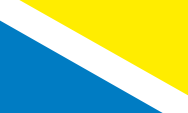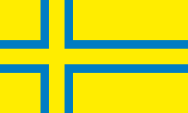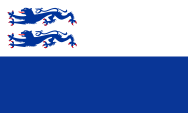mobile View, to the German Version tap the flag


- originally a part of Schleswig
- 1867–1920 part of the Prussian Province of Schleswig-Holstein
- 1920 ceded to Denmark
- Danish administrative district, abolished on 1st of January in 2007
- own names:
Danish: Sønderjylland (South Jutland)
German: Nordschleswig
• Flags
• Meaning/Origin of the Flag
• Coat of Arms
• Meaning/Origin of the Coat of Arms
• Map
• Numbers and Facts
• History
• Origin of the Country's Name

Flag of the German North Schleswig Region,
unofficial,
Source, by: Flags of the World




Flag of the Danish Sønderjylland Region (South Jutland),
unofficial,
Source, by: broderi-butik.dk




Flag of the Association of the German North Schleswiger
Source, by: Wikipedia (DE)




The understanding of the differences in flags and coats of arms requires an understanding of the perspective of identity. For some, the German residents, it is the north of the country of Schleswig, for the other, the Danish residents, it is the south of the country of Jutland. In addition, between 1970 and 2007 there was an official Danish administrative level, the Sønderjyllands Amt. The flag of North Schleswig shows a diagonal from the upper left to the lower right passing white bar between yellow (above) and blue (below). The colours have its roots in the coat of arms.
Source:
Flags of the World,
Wikipedia (DA)


Coat of arms of the German North Schleswig Region,
Source, by: Flags of the World

1970–2007,
Coat of arms of Sønderjyllands Amt,
Source, by: Erik Frohne,
Public domain, via Wikimedia Commons

The coat of arms of the German North Schleswig Region shows a golden bordered blue shield, on it two golden lions, and the stylized Bridge of Immerwatt in gold. The coat of arms of Sønderjyllands Amt showsed s golden shield, on it two blue lions, holding a Danish flag.
Source:
Flags of the World,
Wikipedia (DA)

Position within Denmark:

Source: Morwen, CC BY-SA 3.0,
via Wikimedia Commons

Area: 1.540 square miles
Inhabitants: 252.433 (2006), thereof 90% Danish, 8% Germans
Density of Population: 164 inh./sq.mi.
Capital: Apenrade (Åbenrå), 16.401 inh. (2022)
official Language: Danish
other Languages: German, Sønderjysk
Currency: Danish currency
Time Zone: GMT +1 h
Source: Wikipedia (DA)

prehistory · look Schleswig
1914–1918 · First World War, the German Empire with the Central Powers is defeated to the troops of Entende
1919 · Diktate of Versailles, in the outskirts of the German Empire, in which minorities live, become esablished in 1920 voting areas in which should make referenda about the political affiliation, Schleswig becomes divided into three zones
1920 · plebiscite, zone 1 (North Schleswig) - 74,2% for Denmark, zone 2 (Middle Schleswig) - 19,8% for Denmark, zone 3 (South Schleswig) - no plebiscite, North Schleswig comes to Denmark
1939–1945 · Second World War, at the time of surrender (7th to 9th of May in 1945), Schleswig-Holstein is to the largest parts still in the hand of the German war-might. The government of the German Empire seats still until the 23rd of May in 1945 in Flensburg. After the demobilization of the war-might squads gets the Province of Schleswig-Holstein occupied by the British, and becomes transformed to the Land of Schleswig-Holstein on 23rd of August in 1946.
1949 · Schleswig-Holstein becomes a federal country of the FRG
1955 · German-Danish Policy statements
1st of January 2007 · the Administrative District of Nord Schleswig (Sonderjylland) becomes dissolved und transformes into one of five regions in Denmark
Source:
1. Wikipedia (DE); 2. Wikipedia (DE)

The name of the country "Schleswig" has its roots in the town with the same name, the capital of the country. It actually consists of two parts, "Schlei" and "wig". Schlei is the name of the river on which the town is located, and the word "wig" comes from the Old High German word "wih", meaning "place" or "housing". Schleswig is thus the "Place on the Schlei".
Source: Handbuch der geographischen Namen

Kindly supported by: Oliver Werner

![]()












